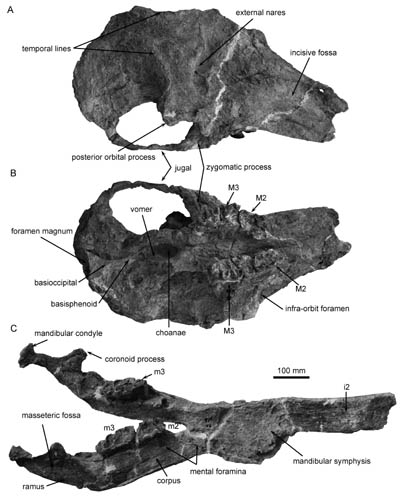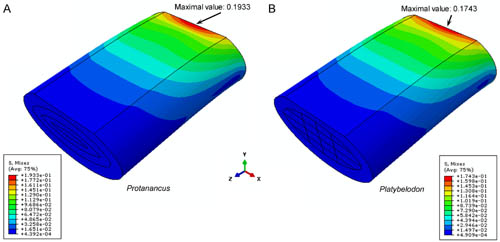Dr. WANG Shiqi from the Institute of Vertebrate Paleontology and Paleoanthropology (IVPP), Chinese Academy of Sciences and his colleagues recently studied two relatively primitive species of Protanancus, Protanancus tobieni and Protanancus brevirostris. The former discovered from Tongxin of Ningxia Province and Qin’an of Gansu Province, about 16 000 000 years ago and the latter from Guanghe of Gansu Province, about 18 000 000 years ago. This study published online in theJournal of Vertebrate Paleontology reveals the intensive competition between Protanancus and Platybelodon based on similarities in their mandibular morphologies and dental microwear patterns, with the former genus disappearing from East Asia by the late middle Miocene.
Protanancus is a shovel-tusked proboscidean with elongated mandibular symphysis and flattened lower tusks, similar to the well-known Platybelodon in morphology. Both of them belong to the subfamily Amebeldontinae. Fossil records indicate that the two genera are symbiotic in East Asia for at least 2 000 000 years. Protanancus was extinct in East Asia at about 16 000 000 years ago; however, Platybelodon was flourish, and tended to extinct in East Asia at about 11 000 000 years ago. For example, in the Dingjiaergou section, Protanancus was discovered only from the 3rd layer; whereas Platybelodon was discovered from the 6th, 17th, and 20th layers, with a large abundance. On the contrary, in the Siwalik area of the south Himalayas, lacking the presence of Platybelodon, Protanancus was not extinct until 11 000 000 years ago.
Microwear study shows that the differences of morphology and distribution of microwear on the cheek teeth of the two genera are statistically insignificant. This result, combined with the similar morphology of the mandible, indicates the two genera had similar feeding behaviors in the similar living environment. If they are indeed living in the same space, strong competition for existence should occurred between Platybelodon and Protanancus.
What is the reason that distinct fates were eventually upon the two similar taxa? The investigation of the inner structure of the lower tusks of the two genera reveals the answer of the question. The inner structure of the lower tusks in Protanancus is concentric laminations as usual proboscideans; whereas that of Platybelodon is specialized as tubular structures. Very simple biomechanical models of finite element have been used to imitate the lower tusks in the two genera. The result indicates that tubular structure shows the greater resistance to the adverse effects of both a heavy load and abrasion than those with concentric laminations. Because the lower tusks are the major feeding apparatus of the two genera. Platybelodon with mechanical advantages of the lower tusk may gradually held ecological space of Protanancus, and eventually led to extinction of the Protanancus, the competitor of Platybelodon.
This work was supported by the National Natural Science Foundation of China, the Strategic Priority Research Program of the Chinese Academy of Sciences, the Ministry of Science and Technology of China, and the National Natural Science Foundation of China. 
Fig. 1, Mandible and lower tusks of Protanancus tobieni. (Image by WANG Shiqi)

Fig. 2, Cranium and mandible of Protanancus brevirostris. (Image by WANG Shiqi)
 Fig. 3, Finite element models of lower tusks of Protanancus (A) and Platybelodon (B). (Image by WANG Shiqi)
|


